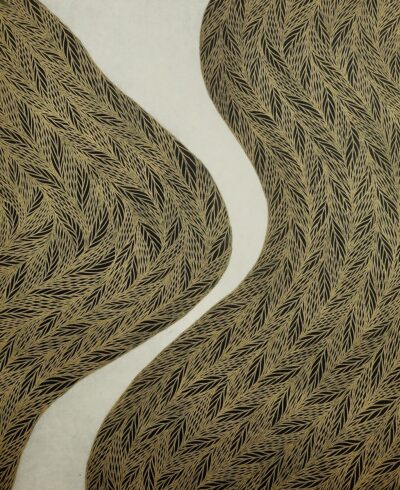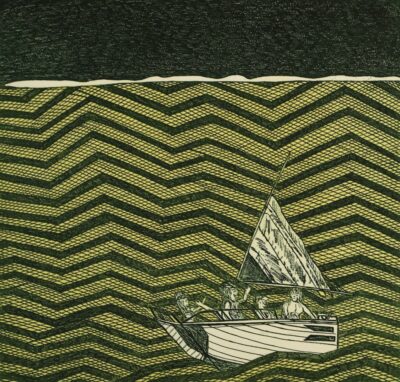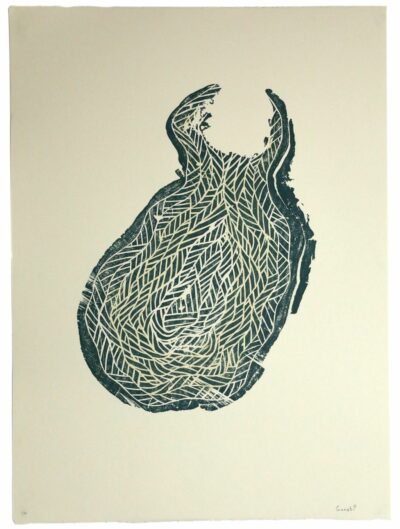gunybi-ganambarr
Homeland: Yaŋunbi
Clan: Ŋaymil
Moiety: Dhuwa
Gunybi has mainly lived and worked as an artist at Gaṉgaṉ, sometimes based at Dhuruputjpi or Yilpara. His mother Mäpuŋu Gumana originates from here but is now deceased. He came to notice as a ceremonial yiḏaki (didjeridu) player sought after by elders to accompany their sacred song. He accompanied the Yolŋu delegations to the opening of the National Museum in Canberra 2001 and the ḻarrakitj installation at the Sydney Opera House 2002, and played at the opening of Djambawa Marawili’s exhibition in the 2006 Sydney Biennale.
Under the tutelage of artists like Gawirrin Gumana and Yumutjin Wunuŋmurra from his mother’s Dhaḻwaŋu clan whilst living on their country he has now assumed ceremonial authority.
He first came to the notice of the Buku-Larrŋgay staff as an artist with a carved and painted Ironwood sculpture of a Wurraṉ or cormorant (a totemic species of his mother clan) in 2002. The wood’s natural shape suggested itself to him and he commenced to reveal the bird within. He then added pigment to achieve the colouring but both, sculpting Ironwood for sale (rather than ceremony), and painting Ironwood are new actions in North East Arnhem land public art. This began a consistent theme of Gunybi following his own inclinations in expressing his vision.
He has combined that with a startling innovative flair to produce groundbreaking sacred art that is at once novel and still entirely consistent with Yolŋu maḏayin (law).
His first recognition in a wider sphere was when he was invited by Brenda Croft of the National Gallery of Australia to enter the National Sculpture Prize in 2005. He submitted one of his first sculpted ḻarrakitj.
In the year of 2008 he was chosen as an exhibiting finalist in the Xstrata Coal Emerging Indigenous Artist Award at the Gallery of Modern Art at Queensland Art Gallery. He went on to win that Award.
In August 2011 Gunybi Ganambarr won the richest Indigenous Art Award $50,000 WAIAA. At this time The Australian wrote;
”When Ganambarr was a young man, senior Yolngu artists recognised his ability and ensured he had the skills and knowledge to create the extraordinary bark paintings on show.
These wonderfully complex and technically brilliant barks sit alongside new works that exploit the potential of materials found around mining sites. Using the layered webs of lines fundamental to traditional Yolngu painting and the incising of lines that characterises Yolngu carving, he has reclaimed the insulation panels and rubber belts discarded by miners and transformed them into panels that combine traditional image-making with an enhanced sense of visual depth and tangible space.
Ganambarr’s work epitomises the innovative and exploratory nature of contemporary Aboriginal arts practice and not surprisingly the judges awarded him the $50,000 main prize.”
Gunybi has had the instinct to introduce radical new forms without offending community tolerance. He has introduced or developed novel forms such as double sided barks, heavily sculpted poles, incised barks, ironwood sculpture, inserting sculptures into poles.
He attributes his confidence in using new materials to his twelve-year stint as a part of a building team in remote homelands.
Gunybi is an energetic participant in ceremonial life who is always cheerful with a robust sense of humour. He is a natural leader amongst his peers. His vigorous zest for life sees him throw himself into whatever activity he is engaged in. He is married to Lamangirra Marawili, a classificatory daughter of Djambawa Marawili.
His inclusion at the APT8 at QAGOMA in 2015 signalled an acknowledgement fo his significance as a contemporary Australian artist. The installation curated by Diane Moon of nine pieces included suspended two sided reclaimed water tank steel, incised and sand covered conveyor belt and irregular ḻarrakitj. All major reviews singled his work out for mention from the eighty artists of 30 countries.
He was featured in The National (a survey of 48 contemporary Australian artists) at the AGNSW in 2017 when John MacDonald of the Sydney Morning Herald wrote ‘”If any artist in this show deserves the epithet “great” .. it’s Gunybi.”
Other commissions at this time included Pacific Bondi permanent wall work in Sydney NSW and a collaboration with Seattle-based Native American Glass artist Preston Singletary where one of his pieces was purchased by one of the US major collectors and tech co founder. In 2017 his work in the collection of US collectors Robert Kaplan and Margaret Levi was accepted into the Metropolitan Museum of Art, New York (The Met) who said of the collection at that time;
“Monumental in both scale and ambition, the paintings are part of a 2016 gift that introduces an electrifying new dimension into The Met’s representation of global contemporary art. On Country: Australian Aboriginal Art from the Robert Kaplan and Margaret Levi Gift explores a particular kind of movement in nature—one that shines or shimmers, as in rain or lightning—and its relationship to time and the ancestral landscape. Mastering dynamic resonance, or shimmer, and finding ways to capture it on canvas is a highly valued visual effect in Australian Aboriginal art, and one on which these Aboriginal artists have built international reputations.”
In 2018 Gunybi was awarded the First Prize in the National Aboriginal and Torres Strait Islander Art Award. As it happened that year there were three other winners from Buku-Larrŋgay Mulka Centre. The winning work was a two panel piece which was made of Alupanel incised by dremel. In October 2019 a three panel piece of the same construction was a major feature of the Tarnanthi Festival at the Art Gallery of South Australia.
During 2023 Gunybi has been invited to complete significant commisions for the National Gallery of Australia and The Metropolitan Museum of Art in New York, his solo exhibition at Annandale Galleries Mali – my spirit/my shadow was highly acclaimed and acquired by several high profile collectors both private and institutional. He also travelled to Washington DC to open Madayin: Eight Decades of Bark Paintings from Yirrkala at the Katzen Art Centre, American University.


